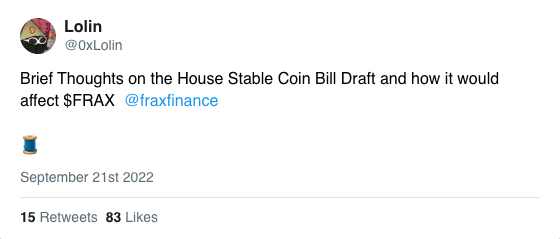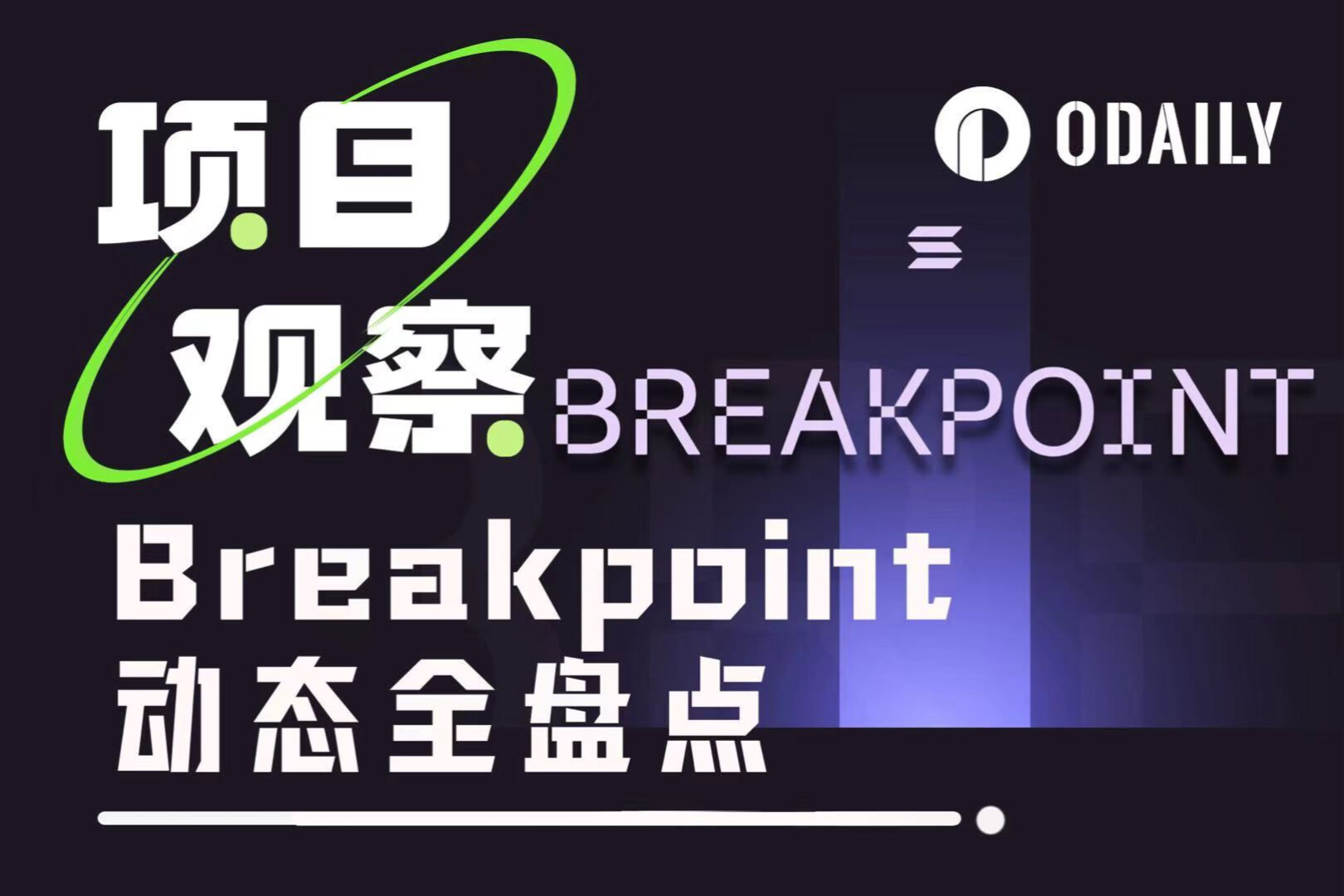Curve:最新稳定币草案的唯一受害者将是美国本身
原文标题:《Sept. 21, 2022: Endogenous Collaterization》
原文编译:0x214,BlockBeats
9 月 20 日,据彭博社报道,美国众议院正在起草监管 Stablecoin 的立法,将对类似 UST 的算法 Stablecoin 实施为期两年的禁令。根据最新版本草案副本显示,发行或创建新的「内生抵押 Stablecoin」(Endogenously Collateralized Stablecoin)是非法的。众议院委员会最早可能于下周对该立法草案进行投票。对此,Curve 发布文章深入解析「内生抵押 Stablecoin」这一全新术语,BlockBeats 对其整理翻译如下:
9 月 20 日消息一出,一时间,推特上充斥了利空消息。一系列关于美国Stablecoin 法案草案的报道被传得人尽皆知,该法案可能彻底击垮 Stablecoin。

市场恐慌情绪迅速蔓延,FXS 应声暴跌 10%。

到底发生了什么事儿?加密研究员 EasonWu 迅速做出总结:
- 该法案将限制美国 Stablecoin 发行商获批准;
- 该法案仍处于早期阶段,仍有变化可能;
- 中心化 Stablecoin 基本不受影响;
- FRAX 将进行小幅调整以符合规定;
- 超额抵押 Stablecoin 不受影响;
- 该法案扼杀 Stablecoin 创新,但仍存在生存空间。
离作风迟缓的立法者真正对该法案采取行动还有一段时间,该法案仍处于草案阶段,这意味着它甚至还没有在国会注册登记。这使得它远远落后于其他几个威胁 Stablecoin 的法案,这些法案还未真正落实。
HR 7328:Stablecoin 透明度法案,Trey Hollingsworth,3 月 31 日
S 3970: Stablecoin 透明度法案,Bill Hagerty,5 月 10 日
HR 4741:数字资产市场结构......Donald S. Beyer Jr.,8 月 13 日
S 4356:负责任的金融创新法案,Lummis/Gillibrand,9 月 15 日
任何一项草案项要真正成为法律,通常都需要经过漫长繁琐的流程,直到摇摆不定的州政客往里面填充了几百页无关紧要的材料才算结束。
立法日程只剩下 9 周,美国国会现在花时间把这些碎片草案整合成一个震荡整个金融生态的法案,可能性不大。
虽说如此,但是当这种「草草了事」的法案讨论被列入议事日程时,这足以引起我们的警惕和担忧。而根据目前已泄漏的信息,这些草案文书实在是太潦草了,足以彰显官方意图干预的急迫心态。
要明白,随着 UST 崩盘,华盛顿特区的紧迫感陡增。Do Kwon 不仅榨干了我们所有人的钱包,他还让一票美国加密用户被扔进了大牢。

当国会在同一个问题上得到两党共识时,遭殃的往往是普通民众。这项草案应该引起人们关注的原因在于,据说它是由 Patrick McHenry 共同发起的,Patrick McHenry 之前被誉为「加密货币冠军」。毕竟目前市场上流窜的消息基本上都是谣言,我们也可以听听这位加密货币冠军的意见。但是,对于在PAC DAO 国会拍卖中竞标他 NFT 的人来说,这可能是个坏消息。
法案中的提到的「内生抵押」(Endogenously-collateralized)Stablecoin 引起了所有人的注意,这个词语让我们梦回高中生物化学课堂。

回想起来,我第一次听说这个词儿还是在 LucaProsperi 一篇很有意思的推特里看到的。

不过,这个词儿少说一个月前就流行起来了。似乎是JerryBrito开始教会了大家使用如此晦涩的语言表达。

我们推测国会使用这种词汇只是为了让自己听起来比较厉害。现在抱怨华盛顿的无知者没有做好功课是一种时尚,所以他们这样鹦鹉学舌以显得聪明。
一个「内生的」系统被定义为一个由其生态内抵押品支持的系统。LUNA 对 UST 来说是内生的,而美元则存在于 USDC 生态之外,所以 USDC 是「外生」的。大约 8% 的 FRAX 由销毁 FXS 来支持,所以 FRAX 是内生的,只需根据需要相应调整其算法。


如果要用技术术语做解释,我们更倾向于使用热力学中的外能(exergonic)和内能(endergonic)反应,与它可能对一个系统造成的吉布斯自由能(Gibbs Free Energy)的变化有关。
或者也可以把这个概念简化为化学的放热/收热(exothermic/endothermic)反应,指的是焓的变化——LUNA 崩盘的最大原因就是因为它是放热(exothermic)的,而且还核爆了其他市场。
国会可能有以下几个动机。第一个动机可能是为 CBDC 扫清障碍,这个话题我们已经撰文讨论过,后续还将发布文章深入探讨。
无论如何,假设 CBDC 会与使用场景完全不同的 Stablecoin 产生直接竞争的想法是愚蠢的。恰恰相反,一个稳健的 Stablecoin 生态系统只会增强 CBDC 的效用。

国会的另一个动机可能更加利他主义,即防止另一次 Luna/UST 式的崩盘。如果情况确实如此,要指责国会的意图可能有点困难。Terra 溃败确实是可怕,很多人受到严重损害,任何人都不希望悲剧重演。
「内生」这一词汇的采用可能只是一次善意的提醒,将类似 UST(主要由 LUNA 支持)的 Stablecoin 单列出来,但是用这么令人费解的词汇可能很难达到效果。在崩溃的时候,Terra 还在努力使其 Stablecoin 成为由比特币等外生抵押品支持的过程中,但是在 Terra 达成目标之前,命运之锤悄然袭来。
管辖权相关问题也引起关注。尽管美国实际行动并不少,但还远不清楚美国是否真的有法律权力来监督其他国家企业。为什么美国拥有这样的权力?美国法律体系中的论据都经不起推敲,这也在 SEC 主席 Gary Gensler 荒谬的权力攫取中得到了展示。
BlockBeats 注:据报道,美 SEC 主席 Gary Gensler 多次公开表示将持续扩大 SEC 权力,全面监管加密市场。

如果该法案真正通过成为法律,其主要效果之一将是削弱美国。把 Stablecoin 创新留在美国境内符合美国的国家利益。保留以美元计价的全部 DeFi 是一个国家安全问题。美国从美元主导地位中获得了很多好处,所以促进美元 Stablecoin 的健康生态系统是美国将这种力量扩展到新经济中的最佳选择。吓跑了想要构建美元 Stablecoin 的创新者,这直接威胁了美国繁荣。
Stablecoin 也是最热门的创新领域之一,结合尖端技术和「产品-市场契合」(PMF)。对 Stablecoin 创新施加限制,实际上只会让创新者转移到那些对美国的废话不屑一顾的管辖区。Stablecoin 的实验创新不会停止,但其总部将会设立在美国执法者管辖范围之外的地区。让 Frax Finance 创始人 Sam Kazemian 在美国 build 才是重中之重!
除此之外,这一切都有点儿傻。撇开骗子不谈,试图建立 Stablecoin 的人都不希望它垮掉。真正的 builder 们关注 Terra,吸取教训以防止类似情况发生。他们不需要立法者来告诉他们 UST 是一个不健全的庞氏骗局。他们正忙着研发真正有效的 Stablecoin 公式,并在此基础上进行扩展。
如果国会真的禁止「有设计缺陷」的 Stablecoin,这是一件坏事吗?这可能比制定一个全面的禁令更可取。然而,「内生」和「外生」的定义非常混乱,这中间可能会产生各种难以想象的灰色地带。我们也都知道,监管机构总是急着去试探自己最远可以把手伸到什么地方,所以,在这样的法律下,我们可以预见好的项目会遭受打击。

其实,如果严格按照草案中「内生」定义,美元本身也可以直接被国会禁止了。毕竟美元自己也是个以拙劣 Token 经济学为基础的算稳。

如果有人出于某种原因想要创建一个极其不稳定的 UST 克隆,他也很容易钻法律空子。以 Terra 名义启动 UST 可能是非法的,但使用一个不同的多签和网站,从技术上来看,也可以算作一个「外生项目」。预计美国政策制定者的全部努力都可以被一个辛普森家族里 Lionel Hutz 级别的律师轻易推翻。

不少人担心此事会对尚未启动的 crvUSD 造成影响,Curve 重申,这和以往一样,这一立法的唯一受害者将是美国本身。

这一切的可悲之处在于,本可以制定有效法规来改善整个行业,而把 DeFi 硬塞进 TradFi 的框架里恰恰是背道而驰……





